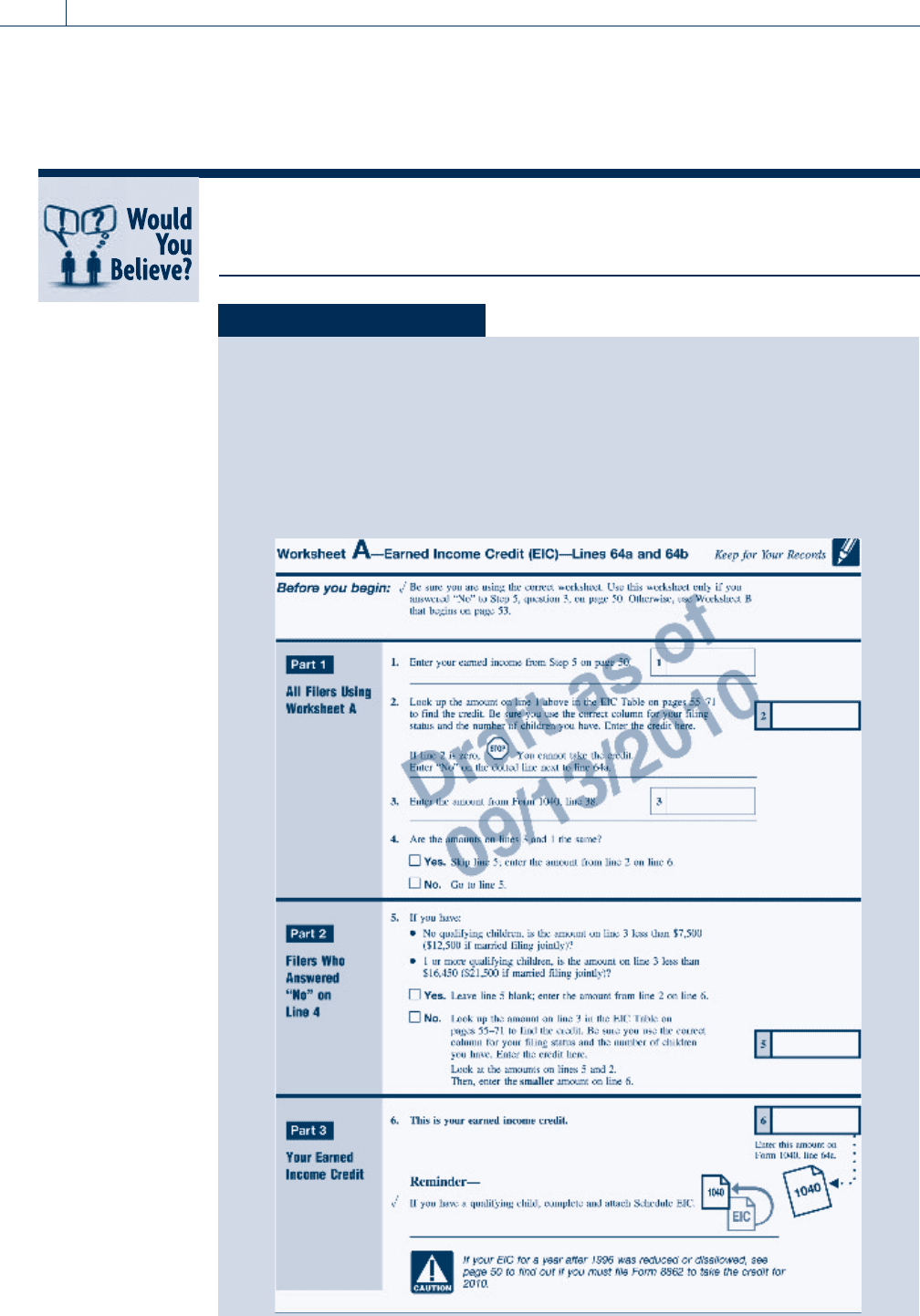Whittenburg Gerald E., Altus-Buller Martha. Income Tax Fundamentals
Подождите немного. Документ загружается.


Chapter 6
Credits and Special Taxes
LEARNING OBJECTIVES
.............................................. .........................
After completing this chapter, you should be able to:
LO 6.1 Calculate the child tax credit.
LO 6.2 Determine the earned income credit (EIC).
LO 6.3 Compute the child and dependent care credit for an
individual taxpayer.
LO 6.4 Apply the special rules applicable to the American
Opportunity and lifetime learning credits.
LO 6.5 Understand the operation of the foreign tax credit, the
adoption credit, and the energy credits.
LO 6.6 Understand the basic alternative minimum tax calculation.
LO 6.7 Apply the rules for computing tax on the unearned income
of minor children and certain students.
LO 6.8 Distinguish between the different rules for married tax-
payers residing in community property states when filing
separate returns.
Overview
This chapter covers the most commonly seen tax credits and several special methods of cal-
culating tax. A credit is a direct reduction in tax liability instead of a deduction from
income. Credits are used because they target tax relief to certain groups of taxpayers.
Because of the progressive rate structure of the income tax, a deductio n provides greater
benefit to higher-income taxpayers, while a tax credit provides equal benefit, regardless
of the taxpayer’s income level. Many credits exist in the tax law that are not covered
here, such as the credit for research and development, the Welfare-to-Work credit, and
the credit for the elderly and disabled.
The second part of this chapter covers the alternative minimum tax (AMT), the tax on
unearned income of minor children (the ‘‘kiddie tax’’), and an overview of community
property law as it applies to the ind ividua l income t ax. Each of these provisions can add
substantial complexity to the individual income tax calculation. For example, if a taxpayer
is subject to the ‘‘kiddie tax,’’ he or she must calculate tax liability in an alternative manner,
using the marginal tax rates of his or her parents.
6-1
Copyright 2010 Cengage Learning. All Rights Reserved. May not be copied, scanned, or duplicated, in whole or in part. Due to electronic rights, some third party content may be suppressed from the eBook and/or eChapter(s).
Editorial review has deemed that any suppressed content does not materially affect the overall learning experience. Cengage Learning reserves the right to remove additional content at any time if subsequent rights restrictions require it.

A credit of up to $8,000 applies to qualified first-time home buyers purchasing
a principal residence with a cost of $800,000 or less after November 6, 2009,
and before May 1, 2010. A similar credit is also available to taxpayers who
are ‘‘long term residents’’ who have owned and used a residence as a principal
residence for any 5-year period during the 8-year period ending on the date of
purchase of a subsequent principal residence. This credit is limited to $6,500.
The credits are phased out for taxpayers with AGI of $225,000 to $245,000 if
married and $125,000 to $145,000 if single, and may be cl aimed on the return
for the year prior to the purchase. These temporary credits are meant to target
assistance to the home construction industry and low to middle income home-
buyers. The credit is not required to be paid back by a taxpayer unless the res-
idence is sold or ceases to be a principal residence within a 3-year period.
EXAMPLE Eugene and Devona qualify for the maxim um $8,000 First Time
Homebuyer Credit and make their first-time home purchase on
January 17, 2010. They may claim the credit on either their 2009 or
their 2010 tax return. If they own and use the property as their pri-
mary residence until January 17, 2013, they will not have to repay
or recapture any of the credit. N
SECTION 6.1
CHILD TAX CREDIT
Individual taxpayers are permitted to take a tax credit based on the number of their
dependent children. The children must be under age 17, U.S. citizens, claimed as depend-
ents on the taxpayer’s return, and meet the definition of ‘‘qualifying child’’ discussed in
Chapter 1.
Maximum Credit and Phase-Outs
For 2010, the child tax cr edit is $1,000 per qualifying child. The available credit begins
phasing out when AGI reaches $110,000 for joint filers ($55,000 for married taxpayers fil-
ing separately) and $75,000 for single or head of household taxpayers. The credit is phased
out by $50 for each $1,000 (or part thereof ) of AGI above the threshold amounts. Since the
maximum credit available depends on the number of qualifying children, the inc ome level
at which the credit is fully phased out also depends on the number of children qualifying
for the credit.
EXAMPLE Hilary and Patrick are married and file a joint tax return claiming
their two children, ages 5 and 7, as dependents. Their AGI for
2010 is $118,700. Hilary and Patrick’s available child tax credit for
2010 is $1,550, computed as their maximum credit of $2,000
($1,000 2 children) reduced by a $450 phase-out. Since Hilary
and Patrick’s AGI is in excess of the $110,000 threshold, the maxi-
mum credit must be reduced by $50 for every $1,000 (or part
thereof) above the threshold amount {$50 [($118,700 $110,000)/
$1,000]}. Thus, the credit reduction equals $450 [$50 9 (rounded
from 8.7)]. N
6-2 Chapter 6
Credits and Special Taxes
Copyright 2010 Cengage Learning. All Rights Reserved. May not be copied, scanned, or duplicated, in whole or in part. Due to electronic rights, some third party content may be suppressed from the eBook and/or eChapter(s).
Editorial review has deemed that any suppressed content does not materially affect the overall learning experience. Cengage Learning reserves the right to remove additional content at any time if subsequent rights restrictions require it.

SECTION 6.2
EARNED INCOME CREDIT
The earned income credit (EIC) is available to qualifying individuals with earned income
and AGI below certain levels. The earned income credit is meant to assist the working
poor. Taxpayers with ‘‘disqualified income’’ (certain types of investment income) exceed-
ing $3,100 in 2010 are not allowed to claim the earned income credit. The earned income
credit is one of the few credits that is refundable. The taxpayer is eligible to claim the credit
and receive a refund equal to the amount of the credit, even if no tax is owed to the federal
government. The credit in effect can produce a ‘‘negative’’ income tax.
The formula for ca lculating the credit depends on the adjusted gross income of the tax-
payer and the number of qualifying children of the taxpayer. The IRS issues an earned
income credit table to assist taxpayers in computing the credit (see Appendix B). To com-
pute the credit, the taxpayer must fill out a form calcul ating the credit from the tables based
on earned income from wages, salaries, and self-employment income. If the taxpayer’s
adjusted gross income is different from earned income and exceeds certain threshhold
amounts shown below, the credit must also be calculated from the tables based on adjusted
gross income, and the smaller of the two credits calculated will be the credit allowed. This
calculation is illustrate d in Worksheet A on the following page.
Earned Income Credit Phaseout Ranges
Number of Qualifying Children
Item One Two Three or More None
Earned Income Amount $ 8,970 $12,590 $12,590 $ 5,980
Maximum Amount of Credit $ 3,050 $ 5,036 $ 5,666 $ 457
Threshold Phaseout Amount
(Single, Surviving Spouse,
or Head of Household)
$16,450 $16,450 $16,450 $ 7,480
Completed Phaseout Amount
(Single, Surviving Spouse,
or Head of Household)
$35,535 $40,363 $43,352 $13,460
Threshold Phaseout Amount
(Married Filing Jointly)
$21,460 $21,460 $21,460 $12,490
Completed Phaseout Amount
(Married Filing Jointly)
$40,545 $45,373 $48,362 $18,470
Appendix B provides tables showing the amount of the earned income credit for each
type of taxpayer.
To be eligible for the credit with no qualifying children, a worker must be over 25 and
under 65 years old and not be claimed as a dependent by another taxpayer. There is no age
requirement for taxpayers with qualifying children. Also, married taxpayers must file a joint
return in order to receive any earned income credit.
Self-Study Problem 6.1
a. Jose and Jane are married and file a joint tax return claiming their three
children, ages 4, 5, and 18, as dependents. Their AGI for 2010 is $105,600.
What is Jose and Jane’s child credit for 2010?
$ ____________
b.Herb and Carol are married and file a joint tax return claiming their three
children, ages 4, 5, and 18, as dependents. Their AGI for 2010 is $125,400.
What is Herb and Carol’s child credit for 2010?
$ ____________
Section 6.2
Earned Income Credit 6-3
Copyright 2010 Cengage Learning. All Rights Reserved. May not be copied, scanned, or duplicated, in whole or in part. Due to electronic rights, some third party content may be suppressed from the eBook and/or eChapter(s).
Editorial review has deemed that any suppressed content does not materially affect the overall learning experience. Cengage Learning reserves the right to remove additional content at any time if subsequent rights restrictions require it.

As of 2010, a qualifying child must generally meet the tests to be a qualifying child as
discussed in Chapter 1, with some special variations primarily related to support and
divorced taxpayers. Please see the IRS Web site for additional information if necessary.
Studies have shown that as many as one out of three earned income credits are
calculated incorrectly or fraudulently. Treasury inspectors estimate that billions
of dollars worth of erroneous claims slip through the cracks every year.
Self-Study Problem 6.2
Dennis and Lynne have a 5-year-old child. Dennis has a salary of $16,200.
Lynne is self-employed with a loss of $400 from her business. Dennis and
Lynne receive $100 of taxable interest income during the year. Their earned
income for the year is $15,800 and their adjusted gross income is $15,900
($16,200 $400 þ $100).
Use Worksheet A and calculate their earned income credit from the EIC
table in Appendix B.
$ ____________
(Wages, Salaries)
(Adjusted Gross Income)
6-4 Chapter 6
Credits and Special Taxes
Copyright 2010 Cengage Learning. All Rights Reserved. May not be copied, scanned, or duplicated, in whole or in part. Due to electronic rights, some third party content may be suppressed from the eBook and/or eChapter(s).
Editorial review has deemed that any suppressed content does not materially affect the overall learning experience. Cengage Learning reserves the right to remove additional content at any time if subsequent rights restrictions require it.

SECTION 6.3
CHILD AND DEPENDENT CARE CREDIT
Congress enacted tax laws to provide benefits to taxpayers with dependents who must be
provided with care and supervision while the taxpayers work. Taxpayers are allowed a
credit for expenses for the care of their children and certain other dependents. To be eli-
gible for the child and dependent care credit, the dependent must either be under the age
of 13 or be a dependent or spouse of any age who is incapable of self-care. If a child’s
parents are divorced, the child need not be the dependent of the taxpayer claiming the
credit, but the child must live with that parent more than he or she lives with the other
parent. For example, a divorced mother with custody of a child may be entitled to the
credit even though the child is a dependent of the father.
Qualified Expenses
The expenses that qualify for the credit include amounts paid to enable both the taxpayer
and his or h er spouse to be employed. Qualified expenses include amounts paid for in-
home care, such as a housekeeper, as well as out-of-home care, such as a day care center.
Overnight camps do not qualify for the credit, nor do activities providing standard educa-
tion. Day camps such as soccer camps and dinosaur camps do qualify for the credit since
they are considered more ‘‘fun and games,’’ than education. Payments to relatives are eli-
gible for the credit, unless the payments are to a dependent of the taxpayer or to the tax-
payer’s child who is under the age of 19 at the end of the tax year. To claim the credit, the
taxpayer must include on his or her return the name, address, and taxpayer identification
number of the person or organization providing the care.
Allowable Credit
For taxpayers with adjusted gross income of less than $15,000, the child and dependent
care credit is equal to 35 percent of the qualified expenses. For taxpayers with income of
$15,000 or more, see Table 6.1 below for the applicable credit percentage. In determining
the credit, the maximum amount of qualified expenses to which the applicable percentage
is applied is $3,000 for one dependent and $6,000 for two or more dependents.
TABLE 6.1 CHILD AND DEPENDENT CARE CREDIT
PERCENTAGES
Adjusted Gross Income Applicable Percentage
Over But not over
$0 15,000 35%
15,000 17,000 34%
17,000 19,000 33%
19,000 21,000 32%
21,000 23,000 31%
23,000 25,000 30%
25,000 27,000 29%
27,000 29,000 28%
29,000 31,000 27%
31,000 33,000 26%
33,000 35,000 25%
35,000 37,000 24%
37,000 39,000 23%
39,000 41,000 22%
41,000 43,000 21%
43,000 No limit 20%
Section 6.3
Child and Dependent Care Credit 6-5
Copyright 2010 Cengage Learning. All Rights Reserved. May not be copied, scanned, or duplicated, in whole or in part. Due to electronic rights, some third party content may be suppressed from the eBook and/or eChapter(s).
Editorial review has deemed that any suppressed content does not materially affect the overall learning experience. Cengage Learning reserves the right to remove additional content at any time if subsequent rights restrictions require it.

Married taxpayers must file a joint return to claim the child and dependent care credit, and
the qualifying dependent care expenses are limited to the lesser of either spouse’s earned
income. For example, if a wife makes $22,000 and her husband earns $1,500, and they
spend $1,900 on child care, the maximum qualifying expenses are $1,500. A special rule applies
when a taxpayer is a full-time student. Full-time students with little or no income are deemed
to have earned income of $250 per month for one dependent and $500 per month for two or
more dependents for purposes of calculating this limitation. For example, if a taxpayer’s spouse
is a full-time student for 9 months of the year and has no income, the maximum amount of the
qualifying expenses for the care of one dependent is $2,250 ($250 per month 9months).
EXAMPLE Harry and Molly Grant are married and file a joint return. They have one
child and pay $4,000 for child care expenses during the year. Harry earns
$16,000 and Molly earns $8,500 during the year, resulting in adjusted gross
income of $24,500. The Grant’s child care credit is calculated as follows:
Qualified expenses
$4,000
Maximum for one dependent 3,000
Credit percentage from Table 6.1
30%
Credit allowed
$ 900
N
EXAMPLE Assume the same facts as in the example above, except the qualified
expenses are $2,100 (instead of $4,000). The credit is 30 percent of
$2,100, or $630. N
SECTION 6.4
EDUCATION TAX CREDITS
The HOPE credit, expanded and renamed the American Opportunity tax credit for 2009
and 2010, and the lifetime learning credit are the education credits available to help qual-
ifying low and middle income individuals defray the cost of higher education.
American Opportunity Credit
The American Opportunity credit is calculated as 100 percent of the first $2,000 of tuition,
fees, books, and course materials, and 25 percent of the next $2,000 for a maximum annual
credit of $2,500 per student. This credit is available for the first 4 years of post-secondary
education. The American Opportunity credit may be claimed for the expenses of students
pursuing bachelor’s or associate’s degrees, or vocational training. Room and board, trans-
portation costs, and personal living expenses are not qualifying expenses.
Tuition, fees, books, and course material expenses that qualify for the American Oppor-
tunity credit can be paid on behalf of the taxpayer, his or her spouse, or dependents.
Self-Study Problem 6.3
Julie Brown has been widowed for 5 years and has one dependent child. Her
adjusted gross income and her earned income are $90,000. Assume her taxable
income is $45,500, her regular tax is $6,228 (line 10 on Form 2441), and her
alternative minimum tax is $3,000 (line 11 on Form 2441). Julie has child care
expenses of $1,500 and expenses for the care of her disabled dependent
mother of $2,400. Calculate Julie’s child and dependent care credit for 2010
using page 1 of Form 2441 on page 6-7.
6-6 Chapter 6
Credits and Special Taxes
Copyright 2010 Cengage Learning. All Rights Reserved. May not be copied, scanned, or duplicated, in whole or in part. Due to electronic rights, some third party content may be suppressed from the eBook and/or eChapter(s).
Editorial review has deemed that any suppressed content does not materially affect the overall learning experience. Cengage Learning reserves the right to remove additional content at any time if subsequent rights restrictions require it.

Section 6.4
Education Tax Credits 6-7
Copyright 2010 Cengage Learning. All Rights Reserved. May not be copied, scanned, or duplicated, in whole or in part. Due to electronic rights, some third party content may be suppressed from the eBook and/or eChapter(s).
Editorial review has deemed that any suppressed content does not materially affect the overall learning experience. Cengage Learning reserves the right to remove additional content at any time if subsequent rights restrictions require it.

6-8 Chapter 6
Credits and Special Taxes
Copyright 2010 Cengage Learning. All Rights Reserved. May not be copied, scanned, or duplicated, in whole or in part. Due to electronic rights, some third party content may be suppressed from the eBook and/or eChapter(s).
Editorial review has deemed that any suppressed content does not materially affect the overall learning experience. Cengage Learning reserves the right to remove additional content at any time if subsequent rights restrictions require it.

The student must carry at least one-half the normal course load for one term during the tax
year to qualify for the credit. In addition, the American Opportunity credit is not available
for any student convicted of a federal or state drug felony.
For 2010, the American Opportunity credit is phased out ratably for joint returns with
income between $160,000 and $180,000 and for singles (or head-of-household filers) with
income between $80,000 and $90,000. The American Opportunity credit is 40 percent
refundable, so up to $1,000 (40 percent of $2,500) may be refunded to the taxpayer if
the credit exceeds the taxpayer’s tax liability.
EXAMPLE Jenny graduates from high school in June 2010. In the fall, she enrolls
for twelve units at Big State University. Big State University considers
students who take twelve or more units full-time students. Jenny’s
father pays her tuition and fees of $2,300. In 2010, the American Oppor-
tunity credit for Jenny is $2,075 ((100% $2,000) þ (25% $300)). N
Qualifying expenses must be paid during the tax year for education during an academic
year beginning during that tax year. If tuition expenses are paid during the tax year for an
academic period beginning during the first 3 months of the following tax year, the expenses
may be claimed during the payment year.
Lifetime Learning Credit
Taxpayers can elect a nonrefundable tax credit of 20 percent of tuition and fees up to
$10,000 in 2010. Books are qualified expenses under the American Opportunity credit,
but not for the lifetime learning credit. The lifetime learning credit is available for expenses
paid for education of the taxpayer, his or her spouse, or dependents. The credit is available
for undergraduate, graduate, or professional courses at eligible educational institutions.
The student can be enrolled in just one cour se and still get the cr edit. The credit is not
subject to felony drug offense restrictions. The purpose of this credit is to encourage tax-
payers to take courses at eligible institutions to acquire or improve job skills.
EXAMPLE In September 2010, Scott pays $1,200 to take a course to improve his
job skills to qualify for a new position at work. His lifetime learning
credit for 2010 is $240 (20% $1,200). N
The lifetime learning credit is phased out at different levels than the American Oppor-
tunity credit. Married taxpayers with income between $100,000 and $120,000, and single
(or head -of-household) taxpayers with income between $50,000 and $60,000 must phase
the credit out evenly over the phase-out range for 2010.
EXAMPLE Jason, a single father, has AGI of $85,000 in 2010. In 2010, he pays $5,000
in qualified tuition for his son, who just started at Party-On University
(POU). Without any limitations, Jason would be entitled to a maximum
American Opportunity credit of $2,500. However, after applying the AGI
limitations, Jason’s American Opportunity credit is reduced by $1,250
($2,500 ($90,000 $85,000)/$10,000), resulting in a credit of $1,250.
Alternatively, assume Jason qualifies for a lifetime learning credit
of $500 (20% $2,500). During 2010, Jason pa id $2,500 of tuition for
a masters degree program in fine arts, which he has been attending
with the hope of eventually becoming a writer. The credit is fully
phased out under the lower phase-ou t ranges for the lifetime learn-
ing credit, so none of the credit may be claimed on his tax return. N
Section 6.4
Education Tax Credits 6-9
Copyright 2010 Cengage Learning. All Rights Reserved. May not be copied, scanned, or duplicated, in whole or in part. Due to electronic rights, some third party content may be suppressed from the eBook and/or eChapter(s).
Editorial review has deemed that any suppressed content does not materially affect the overall learning experience. Cengage Learning reserves the right to remove additional content at any time if subsequent rights restrictions require it.

Limitations
The use of the American Opportunity and lifetime learning credits is limited in the follow-
ing situations:
Married taxpayers who don’t file joint returns may not claim the credits.
Expenses paid for room and board do not qualify.
Expenses paid for nonacademic fees or for expenses that aren’t related to the stu-
dent’s course of instruction do not qualify. Also, expenses for courses that involve
sports, games, and hobbies don’t qualify for the credit unless the course is part of a
degree program.
Qualified educational expenses must be reduced by tax-free scholarships or employer
reimbursements received by students before calculating credits. However, expenses
paid from a gift or inheritance (which is tax free) do qualify for credits.
The credits cannot be used for expenses that are deducted from taxable income on a
tax return for education costs (e.g., unreimbursed job-related educational expenses) .
Students claimed as dependents of other taxpayers are not eligible for educational cred-
its. The persons who claim the students as dependents can claim the educational credit.
EXAMPLE Brenda, a college student, works part-time and pays part of her
college expenses; her parents pay the rest. Although Brenda files her
own tax return, her parents claim her as a dependent on their tax
return. Brenda cannot claim a credit for the qualified amounts she
paid, but her parents can claim a credit both for expenses they paid
and expenses paid by Brenda. N
EXAMPLE Gary, a college student, works part-time and pays part of his college
expenses. His parents pay for the rest. His parents have high income
and would not be able to claim an education credit for Gary. If Gary’s
parents decide not to claim Gary as a dependent, even though he
qualifies as a dependent, Gary can claim an education credit on his
own tax return for the expenses he paid and also for the expenses his
parents paid. Since Gary could have been claimed as a dependent by
his parents, he is not allowed to claim a dependency exemption on
his own tax return. N
Using Both Credits
Taxpayers cannot take both the American Opportunity credit and the lifetime learning credit
for the same student in the same tax year. An American Opportunity credit can be claimed
for one or more students, and the lifetime learning credit can be claimed for other students in
the same tax year. Also, the choice in one year doesn’t bind the taxpayer for future years. For
example, a taxpayer can claim the American Opportunity credit for a student in one tax year
and take the lifetime lear ning credit fo r the same student the followin g year. T axpayers
should claim the credit or combination of credits that gives the best tax benefit.
EXAMPLE In 2010, the Browns have a son, Boyd, who is a freshman in college,
and a daughter, Beth, who is a senior in college. They can take both
the American Opportunity credit for Boyd and the lifetime learning
credit for Beth for any qualifi ed educational expenses they pay in
2010. N
6-10 Chapter 6
Credits and Special Taxes
Copyright 2010 Cengage Learning. All Rights Reserved. May not be copied, scanned, or duplicated, in whole or in part. Due to electronic rights, some third party content may be suppressed from the eBook and/or eChapter(s).
Editorial review has deemed that any suppressed content does not materially affect the overall learning experience. Cengage Learning reserves the right to remove additional content at any time if subsequent rights restrictions require it.
